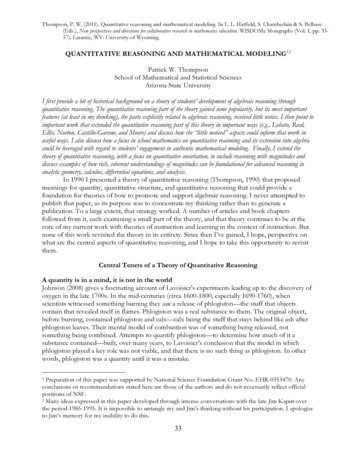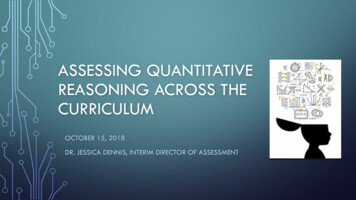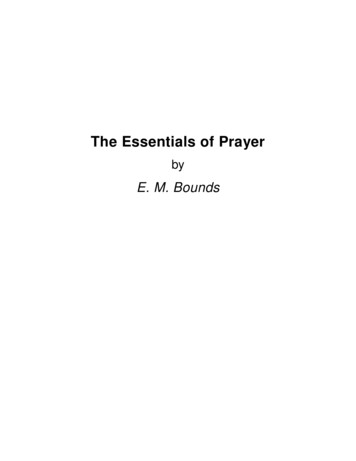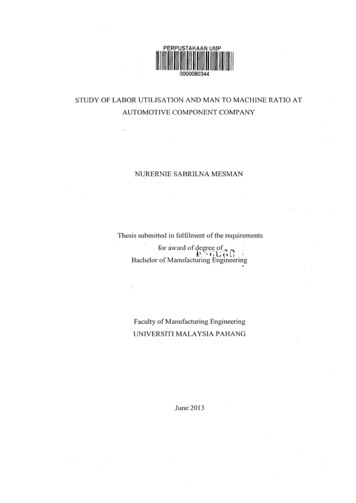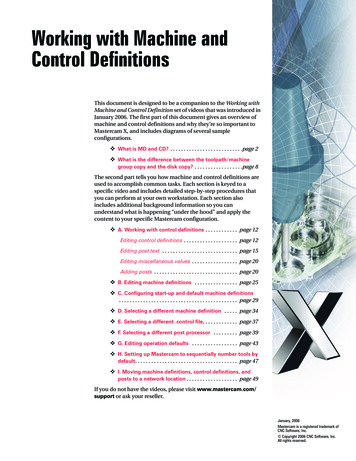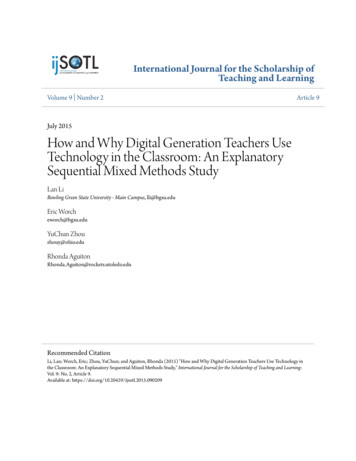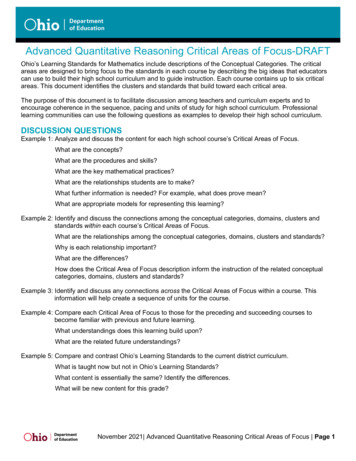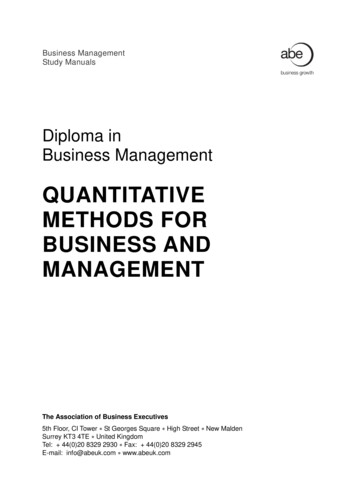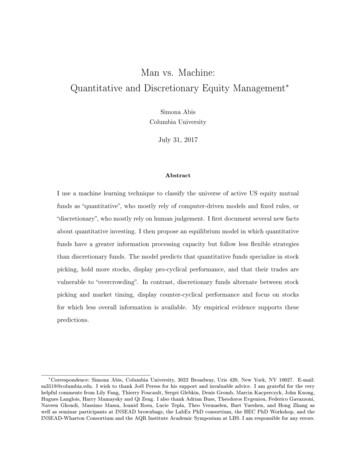
Transcription
Man vs. Machine:Quantitative and Discretionary Equity Management Simona AbisColumbia UniversityJuly 31, 2017AbstractI use a machine learning technique to classify the universe of active US equity mutualfunds as quantitative , who mostly rely of computer-driven models and xed rules, or discretionary , who mostly rely on human judgement. I rst document several new factsabout quantitative investing. I then propose an equilibrium model in which quantitativefunds have a greater information processing capacity but follow less exible strategiesthan discretionary funds. The model predicts that quantitative funds specialize in stockpicking, hold more stocks, display pro-cyclical performance, and that their trades arevulnerable to overcrowding . In contrast, discretionary funds alternate between stockpicking and market timing, display counter-cyclical performance and focus on stocksfor which less overall information is available.My empirical evidence supports thesepredictions. Correspondence: Simona Abis, Columbia University, 3022 Broadway, Uris 420, New York, NY 10027.E-mail:sa3518@columbia.edu. I wish to thank Joël Peress for his support and invaluable advice. I am grateful for the veryhelpful comments from Lily Fang, Thierry Foucault, Sergei Glebkin, Denis Gromb, Marcin Kacperczyk, John Kuong,Hugues Langlois, Harry Mamaysky and Qi Zeng. I also thank Adrian Buss, Theodoros Evgeniou, Federico Gavazzoni,Naveen Ghondi, Massimo Massa, Ioanid Rosu, Lucie Tepla, Theo Vermaelen, Bart Yueshen, and Hong Zhang aswell as seminar participants at INSEAD brownbags, the LabEx PhD consortium, the HEC PhD Workshop, and theINSEAD-Wharton Consortium and the AQR Institute Academic Symposium at LBS. I am responsible for any errors.
1IntroductionAdvances in computational technology and data analytics are revolutionizing the asset managementindustry (World Economic Forum 2015). As David Siegel, co-head of Two Sigma, a prominent hedgefund, puts it: The challenge facing the investment world is that the human mind has not becomeany better than it was 100 years ago, and it's very hard for someone using traditional methods tojuggle all the information of the global economy in their head (. . . ). Eventually the time will comethat no human investment manager will be able to beat the computer . Yet little is known about theprevalence of quantitative strategies in the mutual fund industry, their e ect on fund performance,and their in uence, if any, on asset prices. My paper lls this gap by carrying out a detailed analysisof quantitative investing in the US equity mutual fund universe.The rst step of my analysis is to develop a novel methodology to classify funds as quantitativeor discretionary (i.e., non-quantitative). Here quantitative funds are those basing their investmentprocesses primarily on quantitative signals generated by computer-driven models using xed rulesto analyze large datasets. Instead, discretionary funds rely mostly on decisions by asset managerswho use information and their own judgment. I collect mutual fund prospectuses for 2,607 fundsfrom 1999 to 2015 from the Securities and Exchange Commission (SEC). I manually categorize usingobjective criteria a subsample of 200 funds, which then serves as a training sample for a machinelearning algorithm. That procedure results in a dataset of 599 quantitative and 1,851 discretionaryfunds.The classi cation then allows me to report a number of stylized facts about quantitative funds. Ind that they have quintupled in number and more than quadrupled in size over 1999 2015, growingat double the rate as discretionary funds. Currently their total assets under management (AuM)amount to 412 bn or roughly 14% of the AuM of US equity mutual funds. Since 2011, in particular,capital has been owing from discretionary to quantitative funds. On average, quantitative fundsare younger (13.0 vs. 14.5 years) and smaller ( 552 mm vs. 1.2 bn); they charge 10% lower expenseratios and 9% lower management fees, exhibit 10% higher turnover, own stocks that load more onvalue and momentum factors, and hold less cash than discretionary funds.They also experienceout ows during recessions that are signi cantly stronger than those experienced by discretionaryfunds.1I focus next on understanding how quantitative funds di er from their discretionary peers in terms ofinvestment style and performance, and on how their growing importance might a ect stock markets.One might expect quantitative funds to hold portfolios that are less susceptible to human managers'limited information processing capacity. On the other hand, these funds might be less exible inadapting their strategies to changing market conditions, and their trades might be more correlated(Khandani and Lo 2007).To guide my analysis of investment style and performance, I extend the model by Kacperczyk, Van1All di erences are signi cant at the 1% level.1
Nieuwerburgh, and Veldkamp (2016; hereafter KVV). Theirs is a static general equilibrium modelwith multiple assets subject to a common aggregate shock and individual idiosyncratic shocks. Theseassets are traded by two categories of agents:skilled investors, and unskilled investors.Skilledinvestors have limited learning capacity, which they allocate to learning about idiosyncratic shocks(stock picking) or aggregate shocks (market timing). KVV show that skilled investors optimally focustheir learning on the aggregate shock in recessions, modeled as periods of greater risk aversion and2higher volatility of the aggregate shock , and on idiosyncratic shocks in expansions. The intuitionis that the marginal bene t of learning about a shock increases with its volatility. So in recessions,when the aggregate shock volatility rises, the incentive to learn about it increases.This e ect ismagni ed by the much larger supply of the aggregate shock (i.e., since it a ects all stocks).I interpret KVV's skilled investors as being discretionary investors.I then add to their model asecond group of skilled investors: quantitative investors, whom I assume to have unlimited learningcapacity but to only be able to learn about idiosyncratic shocks. This key assumption is motivatedby survey evidence (Fabozzi, Focardi, and Jonas 2008) and by my textual analysis of prospectuses.Both pieces of evidence indicate that quantitative equity funds tend to specialize in stock-speci cinformation and to incorporate marketwide dynamics in their models via price-based signals such3 Given the importance of this assumption for my analysis, I will further test its4plausibility in the data. The model yields seven testable predictions.as momentum.1.The presence of quantitative investors mitigates the pattern uncovered by KVV, whereby dis-cretionary investors switch the focus of their learning across the business cycle.If quantitativeinvestors represent a large enough share of the market, then discretionary investors instead chooseto specialize in learning about the aggregate shock. This pattern re ects a substitution e ect: themore investors learn about a given shock, the lower the value to others of learning about it.2.Quantitative investors hold a larger number of stocks than discretionary investors. The reasonis that investors optimally hold those assets about which their signals are more precise.Becauseof their unlimited capacity to learn about idiosyncratic shocks, quantitative investors have greatersignal precision regarding the payo s of more assets; hence it is optimal to hold more of them.3.When learning about idiosyncratic shocks, discretionary investors focus on stocks for whichrelatively less information can be learned. That approach allows them to reduce their informationdisadvantage, or2information gap, relative to quantitative investors.Various studies have shown that: aggregate stock market volatility is higher in recessions (Hamilton and Lin1996; Campbell et al. 2001; Engle and Rangel 2008); risk premia and Sharpe ratios are counter-cyclical (Fama andFrench 1989; Cochrane 2006; Ludvigson and Ng 2009; Lettau and Ludvigson 2010); and aggregate risk aversion risesin recessions (Dumas 1989; Chan and Kogan 2002; Garlenau and Panageas 2012).3Although this assumption is plausible for modeling equity mutual funds, it may be questionable in the contextof some hedge funds (e.g. quantitative macro funds specialize in timing the market using trend-following signals andsignals derived from the analysis of macroeconomic information).4I report below two ndings supporting this hypothesis. First, I nd that quantitative funds that display consis-tently high stock-picking ability in expansions do not switch to displaying high market-timing ability in recessions,indicating that these funds indeed are not exible in changing the focus of their strategies. Second, I nd that that nofunds consistently display high market-timing ability throughout the business cycle, indicating in turn that no fundis endowed with the ability to learn only about aggregate shocks.2
4.Dispersion of opinion, and hence of holdings, is greater among discretionary investors thanamong quantitative investors. This follows from discretionary investors' limited learning capacitywhich they need to allocate optimally across shocks.They might choose to learn about di erentshocks, as the marginal bene t of learning about shocks is decreasing in the average precision ofprivate signals about those shocks in the market substitution e ect. This leads to more disperseportfolio allocations.5.Quantitative investors display pro-cyclical performance. In expansions, though, two counteractinge ects are at play: higher signal precision about idiosyncratic shocks (which, in expansions, mattermore than the aggregate shock) helps quantitative investors outperform the market; but if thefraction and signal precision of quantitative investors are too high, their advantage is eroded andthey tend to underperform.6.Performance is counter-cyclical for discretionary investors (as in KVV) thanks to their superiorinformation about the aggregate shock, which is more relevant in recessions. As the share of quantitative investors rises, their performance is worsened in expansions and improved in recessions, dueto a substitution e ect.7.As the share of quantitative investors increases, so does the price informativeness of idiosyn-cratic shocks.However, the e ect on the aggregate shock's price informativeness varies over thebusiness cycle. In expansions, aggregate price informativeness is enhanced but only when the shareof quantitative investors is high enough that discretionary investors are induced to specialize inlearning about the aggregate shock (Prediction 2).In recessions, aggregate price informativenessalways decreases with the share of quantitative investors; this is because an increase in the shareof quantitative investors reduces that of discretionary investors, who are the only investors able tolearn about the aggregate shock.To test these predictions, I merge my sample with the CRSP mutual fund and stock databases, theThompson Financial Spectrum dataset, the CRSP Mutual Fund Holdings dataset, IBES analystsforecasts, and Dow Jones news.First, I study the extent to which funds engage in stock picking and market timing measured, as inKVV, by the covariance of fund holdings with future earnings surprises and with future growth inindustrial production respectively.To begin with, I nd that KVV's prediction applies only to funds I classify as discretionary: suchfunds that display consistently high stock-picking ability in expansions also show high market-timingability in recessions (68% higher than the average fund).Next I test the plausibility of my new key assumption that is, quantitative funds only learn aboutidiosyncratic shocks. Quantitative funds that display consistently high stock-picking ability in expansions do not display high market timing ability in recessions, and no funds consistently displayhigh market-timing ability throughout the business cycle. These ndings lend support to the model'sassumption about funds' learning technologies by suggesting, respectively, that quantitative funds3
do not exibly adapt the focus of their learning throughout the business cycle, and that no fund isendowed with the ability to learn only about aggregate shocks.Finally, in accordance with Prediction 1, I nd that, with increases in the share of quantitativefunds (measured as the relative TNA that quantitative funds manage or as the fraction of the USstock market capitalization held by quantitative funds in my sample), the stock-picking ability ofdiscretionary funds in expansions decreases signi cantly (by one standard deviation for every 17%increase in the share of quantitative funds) and their market-timing ability in recessions increasessigni cantly (by one standard deviation for every 6.8% increase in the share of quantitative funds).Second, I nd that quantitative funds on average hold considerably more stocks than do discretionaryfunds (225 vs. 117). Additionally, the distribution of quantitative funds' number of holdings is moreskewed, with a signi cant portion of funds holding up to 1000 stocks. This translates into greaterportfolio diversi cation, and hence lower idiosyncratic volatility (up to 15% less). This result is inline with Prediction 2.Third, I proxy for the average information gap in the stocks held by quantitative and discretionaryfunds with their average size, age, media mentions and analysts coverage. The idea is that moreinformation is available about stocks for which there exists a longer history and that enjoy greater media and analyst coverage, making such stocks more easily processable with quantitative approaches;hence the information gap should be greater. I nd that the information gap is smaller for the stocksheld by discretionary funds; they hold stocks that are younger (44 months younger than the 3515months average) and have fewer monthly mentions in the media (31 fewer than the 275 average).Although there is no signi cant di erence in analyst coverage, I nd that all funds holding stocksless mentioned in the news or less covered by analysts perform marginally better and that thee ect is signi cantly greater for discretionary funds (about 36% higher depending on the measure).This result is consistent with Prediction 3.Fourth I nd that discretionary investors have signi cantly more disperse holdings than quantitativefunds do. This result holds for di erent measures of dispersion of holdings: the cumulative squareddi erence in the weight allocated by each fund to stocks relative to the weight allocated by theaverage fund of the same type (dispersion), and the average percentage of funds of the same typethat hold the same stocks (commonality). This result is in line with Prediction 4.Fifth, I nd that the performance of quantitative funds in expansions has been declining over timedue to overcrowding , caused by the increase in the share of quantitative funds in the marketand their tendency to hold overlapping portfolios. In the post-subprime expansion (Jul 2009 Dec2015), quantitative funds earn 79.8 bp less than before the 2001 recession (Dec 1999 Feb 2001)and 12 bp less than in the expansion that preceded the sub-prime crisis (Jan 2002 Nov 2007). Asa consequence, in the latest expansion they do not signi cantly outperform the market, despitedisplaying better Sharpe ratios. Finally, funds with a lower average commonality in holdings displaybetter performance. This outcome is in line with Prediction 5.5Di erences are statistically signi cant.4
Sixth, I nd that discretionary funds' performance is counter-cyclical: they perform signi cantlybetter in recessions (by 31.0 bp for CAPM alphas, 8.5 bp for three-factor alphas and 2.9 bp for 4factor alphas); while displaying a small negative alpha in expansions (insigni cant for CAPM alphas,-7 bp for 3-factor alphas and -5 bp for 4-factor alphas). Such behavior is consistent with Prediction6.The paper proceeds as follows.Section 2 reviews the related literature.Section 3 describes theclassi cation method and new facts about quantitative and discretionary funds. Section 4 presentsthe model and its implications. Section 5 reports empirical tests and robustness checks. Section 6concludes. The Appendix features details of the classi cation method and the proofs of the model.2 Related LiteratureMy paper relates to three streams of research. First and foremost, it contributes to the literatureon mutual funds. Research on quantitative investing therein is scarce and relies on small samplesbecause of the di culty in identifying quantitative traders. Casey, Quirk & Associates (2005) reportthat quantitative managers outperform discretionary funds (32 funds over 2000 2004), and Ahmedand Nanda (2005) that they outperform their peers in small-cap stocks and charge lower management fees (22 funds over 1980 2000). Khandani and Lo (2007) attribute the August 2007 QuantMeltdown sudden losses su ered by many long-short quantitative hedge funds to the rapid unwinding of overcrowded strategies. Finally Harvey et al. (2016) analyze di erences in performancebetween quantitative and discretionary hedge funds. They nd that discretionary and quantitativeequity hedge funds perform similarly while quantitative macro hedge funds outperform their discretionary counterparts. I nd, in my comprehensive sample, somewhat consistent results (e.g., onfees, performance and portfolio overlap), but show that many need to be quali ed, for instance toaccount for the rise in quantitative investing and for business cycles.Additional evidence comes from the survey by Fabozzi, Focardi, and Jonas (2008).The surveyunderscores the diminished relative performance of quantitative funds during the subprime crisis,for which some of the main causes were identi ed as rising correlations and fundamental marketshifts. Respondents indicated that adding macroeconomic concepts directly into models was one ofthe least useful potential improvements an expression of how the successful forecasting of nancialmarkets relies on model adaptability (Fabozzi and Focardi 2009). Yet most contemporary adaptivemodels (e.g., regime-switching models) require very long time series for accurate estimation, whichare generally not available for nancial data.I nd con rmation of this preliminary evidence inthe analysis of the prospectuses of the funds I classify. This motivated my choice of assumptions inmodeling quantitative funds' learning technology.An important branch of the mutual fund literature focuses on performance.It o ers little evi-dence that mutual funds outperform the market unconditionally, be it by picking stocks or timingthe market. Conducting a ner analysis, recent studies demonstrate that their performance varies5
over the business cycle (Glode 2011; Kosowski 2011; de Souza and Lynch 2012). Kacperczyk, VanNieuwerburgh, and Veldkamp (2014), in particular, show empirically that managers who are goodstock-pickers in expansions are also good market-timers in recessions. My empirical results underscore too the importance of conditioning on the state of the business cycle, and of distinguishingmarket timing from stock picking.From a theoretical perspective, the shifting skills and performance of funds across the business cyclehas been explained through rational inattention (Sims 2003; Mackowiak and Wiederholt 2009 and2015 ; Van Nieuwerburgh and Veldkamp 2010; Kacperczyk, Van Nieuwerburgh, and Veldkamp 2014;KVV). This literature argues that investors with limited information processing capacity make rational choices about what information to focus on. KVV show both theoretically and empirically thatthese investors optimally shift their attention from idiosyncratic shocks in expansions to aggregateshocks in recessions, leading to cyclicality in performance.My model extends theirs by allowingskilled investors with di erent learning capabilities and exibilities to interact in equilibrium. Thus,I explain how quantitative and discretionary investors compete in equilibrium and how the rise inquantitative investment a ects the choices and pro tability of discretionary funds. Glasserman andMamaysky (2016) also contribute to this debate by developing a model in which some investors areinformed about aggregate shocks and others about idiosyncratic shocks, but only the latter tradeagainst idiosyncratic noise traders. They show that an endogenous bias exists towards idiosyncraticinformativeness. This is consistent with my model when the share of quantitative investors is large.The paper's second main contribution is to the growing literature that studies the impact of technological changes on nancial markets. The themes therein include payments systems (e.g., bitcoin),disintermediation (e.g., peer-to-peer lending), and disruptive innovations (e.g., ntech). Most workon quantitative investing focuses on speci c investors, high-frequency traders ( HFT ), who exploitprogress in communications technology and machine-based analytics to execute trades at very highspeed. Here the unit of analysis is a trade, not a trader, thus circumventing the aforementioned identi cation challenge. Though worries about adverse selection remain important, most of the evidencesuggests that HFT improve market quality through lower bid-ask spreads (Menkveld 2015, Bershovaand Rakhlin 2013, Malinova, Park, and Riordan 2013, Stoll 2014, Riordan and Storkenmaier 2012,Boehmer, Fong, and Wu 2015) and more e cient pricing (Carrion 2013, Riordan 2014a, Conrad,Wahal, and Xiang 2015, Chaboud et al. 2014, Hasbrouck and Saar 2013). An ongoing criticism isthat HFT exacerbate market movement and magnify volatility because their trades tend to be highlycorrelated (Shkilko and Sokolov 2016). Though my paper does not speak directly to the literatureon HFT (in my model, all trading takes place at the same speed), I uncover in the data a trade-o which has a similar avor. Speci cally, I nd, on one hand, that quantitative investing contributesto price e ciency, but on the other, that it has the potential to magnify market instability becausemachine-based trades tend to overlap signi cantly.The third stream of literature related to my paper analyses stocks connectivity and fragility. Recentresearch shows that stocks with greater commonality in their ownership are more exposed to nonfundamental risk. Greenwood and Thesmar (2011) de ne stocks as fragile if they are exposed to more6
non-fundamental risk either because of concentrated ownership or because owners face correlatedliquidity shocks; nding that fragility predicts stocks volatility. Anton and Polk (2014) show that thedegree of shared ownership forecasts cross-sectional variation in return correlation. I nd evidencethat quantitative funds have greater commonality in their portfolio holdings. The rise in these typesof funds might in turn impact stock return volatility and correlation.3 Quantitative versus Discretionary FundsI develop a novel methodology, based on machine-learning analysis of fund prospectuses, to classifyfunds as quantitative or discretionary.In this section I describe the data employed and also theclassi cation methodology. I then report a series of new facts about quantitative and discretionaryfunds based on this classi cation.3.1 DataFollowing the path of most data availability, I focus on diversi ed active US equity mutual fundsfeatured in the CRSP Mutual Fund dataset. Thus I exclude international funds, sector funds, unbalanced funds, index funds, and underlying variable annuities.focusing only on those observations that are datedafterIncubation bias is eliminated bythe fund inception date (Elton, Gruber,and Blake 2001). To focus on funds for which holdings data are most complete, I also exclude fundswith less than 5 million AuM or holding fewer than 10 stocks or devoting less than 80% of theirportfolios to standard equities (Kacperczyk, Sialm, and Zheng 2008).Funds often market di erent share classes of the same portfolio di ering only in target clients,fees structure or fund withdrawal restrictions.I follow the mutual fund literature and group theobservations of all share classes of a given fund for every point in time into a single observation.Toward that end I keep the qualitative variables (e.g., fund name, start date) of the oldest fund, addthe TNA of all share classes, and weight all other variables (e.g., returns) by lagged total net assets.Stock holdings data are obtained from merging the Thompson CDA/Spectrum Mutual Fund Holdings dataset for 1999 2003 and the CRSP Mutual Fund Holdings dataset for 2004 2015 to theCRSP Survivorship-Bias-Free mutual fund dataset.This choice is dictated by the fact that theCRSP dataset also reports short positions held by mutual funds, while Thompson doesn't. Di erent short-selling practices are one of the characteristics along which quantitative and discretionaryfunds di er. CRSP holdings are available starting from July 2001 but the holding's e ective datesis only reported starting from December 2003, which is when I start using it. The sample periodstarts in December 1999 and ends in December 2015; that is the period for which fund prospectusescontain the information needed for my classi cation (see Section 3.2). This nal condition restrictsthe sample to 2,607 unique funds and 250,427 fund-month observations. The number of funds eachmonth ranges from 516 funds in (December 2000) to 2,065 funds (March 2011); see Figure 1.7
To construct di erent variables, I also use the CRSP stock-level database, seasonally adjustedindustrial production from Federal Reserve economic data, Compustat earnings, IBES forecasts,Fama French factors, and Dow Jones news mentions.3.2 Classi cation MethodologyI collected prospectuses for the 2,607 funds from December 1999 to December 2015 from the SEConline database. One section of the fund prospectus, usually entitled Principal Investment Strategies , corresponds to item 9 of the N-1A mandatory disclosure form, where funds must disclose TheFund's principal investment strategies, including the particular type or types of securities in whichthe Fund principally invests or will invest and Explain in general terms how the Fund's adviserdecides which securities to buy and sell. This requirement was added after the 1998 amendment ofmandatory disclosures; all funds were required to comply beginning in December 1999, the startingdate of my analysis.Quantitativetionaryfunds are de ned as those with an investment process based primarily on quantitativesignals generated by computer-driven models using xed rules to analyze large datasets.Discre-funds are de ned as those with an investment process based mainly on decisions made byasset managers, who use information and their own judgment. Although discretionary funds maywell employ quantitative measures, their main stock selection criterion remains human judgment.Conversely, quantitative funds might incorporate some level of human overlay, for instance, doublechecking the soundness of automatically generated trading signals. Hybrid cases, in which extensivequantitative stock screening is used before discretionary analysis determines the nal trading decision, are grouped with quantitative funds.Most funds indicate, in their Principal Investment Strategies , whether they employ quantitativemethods. For quantitative funds, a typical statement is as follows:The Portfolio's subadviser utilizes a quantitative investment process.A quantitativeinvestment process is a systematic method of evaluating securities and other assets byanalyzing a variety of data through the use of models or systematic processes to generate an investment opinion. The models consider a wide range of indicators includingtraditional valuation measures and momentum indicators. These diverse sets of inputs,combined with a proprietary signal construction methodology, optimization process, andtrading technology, are important elements in the investment process. Signals are motivated by fundamental economic insights and systematic implementation of those ideasleads to a better long-term investment process. (Advanced Series Trust AST AQR LargeCap Portfolio)In contrast, a discretionary fund's prospectus might state:8
The fund's portfolio construction combines a fundamental, bottom-up research processwith macro insights and risk management. The fund's portfolio managers, supportedby a team of research analysts, use a disciplined opportunistic investment approach toidentify stocks of companies that the portfolio managers believe are trading materiallybelow their intrinsic market value, have strong or improving fundamentals and have arevaluation catalyst. The fund seeks exposure to stocks and sectors that the fund's portfolio managers perceive to be attractive from a valuation and fundamental standpoint.Portfolio position sizes and sector weightings re ect the collaborative investment processamong the fund's portfolio managers and research analysts. The portfolio managers alsoassess and manage the overall risk pro le of the fund's portfolio. (Advantage Funds Inc.:Dreyfus Opportunistic US Stock Fund)I classi ed manually a subsample of 200 prospectuses from di erent funds while using various objective criteria: the word quantitative or systematic appearing in the fund name, the fund beingidenti ed in the media as a quantitative or discretionary mutual fund. Next, I pre-processed theprospectus extracts describing the rm's principal investment strategies and employed the bag ofwords approach to transform that text into a matrix of.6combinations) suitable for automatic processingfeatures(i.e. stemmed words and two-wordsI then used nested cross-validation to train di erent machine learning classi cation algorithms:bernoulli and multinomial naive Bayes, logistic regression, linear and nonlinear support vector machines,k-nearest neighbors, and random forest. The good
The rst step of my analysis is to develop a novel methodology to classify funds as quantitative or discretionary (i.e., non-quantitative). Here quantitative funds are those basing their investment processes primarily on quantitative signals generated by computer
